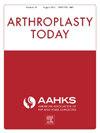微创全膝关节置换术的低-中-股入路
IF 2.1
Q3 ORTHOPEDICS
引用次数: 0
摘要
低-中股入路是全膝关节置换术(TKA)中微创技术的改进。该技术包括沿着股内侧斜肌做一个精确的肌肉分裂切口,保留肌腹的1厘米宽的内侧袖带,在保持足够的手术暴露的同时保留伸肌机制。我们假设低-中股入路通过优化股内侧斜肌完整性,将术后疼痛最小化,加速恢复,并提高患者满意度。它适用于原发性TKA,并适应具有挑战性的解剖变化。在这项研究中,我们描述了我们的手术技术和经验,这种方法用于传统的原发性TKA,代表了股中肌谱的改进,优先考虑肌肉保存,同时保持足够的暴露。本文章由计算机程序翻译,如有差异,请以英文原文为准。
The Low Mini-Midvastus Approach for Minimally Invasive Total Knee Arthroplasty
The low mini-midvastus approach is a refinement of minimally invasive techniques in total knee arthroplasty (TKA). This technique involves making a precise muscle-splitting incision along the vastus medialis obliquus, retaining a 1-cm wide inferomedial cuff of the muscle belly, preserving the extensor mechanism while maintaining sufficient surgical exposure. We hypothesize that the low mini-midvastus approach minimizes postoperative pain, accelerates recovery, and enhances patient satisfaction by optimizing vastus medialis obliquus integrity. It is suitable for primary TKA and adaptable to challenging anatomical variations. In this study, we describe our surgical technique and experience with such an approach for conventional primary TKA that represents a refinement of the midvastus spectrum that prioritizes muscle preservation while maintaining adequate exposure.
求助全文
通过发布文献求助,成功后即可免费获取论文全文。
去求助
来源期刊

Arthroplasty Today
Medicine-Surgery
CiteScore
2.90
自引率
0.00%
发文量
258
审稿时长
40 weeks
期刊介绍:
Arthroplasty Today is a companion journal to the Journal of Arthroplasty. The journal Arthroplasty Today brings together the clinical and scientific foundations for joint replacement of the hip and knee in an open-access, online format. Arthroplasty Today solicits manuscripts of the highest quality from all areas of scientific endeavor that relate to joint replacement or the treatment of its complications, including those dealing with patient outcomes, economic and policy issues, prosthetic design, biomechanics, biomaterials, and biologic response to arthroplasty. The journal focuses on case reports. It is the purpose of Arthroplasty Today to present material to practicing orthopaedic surgeons that will keep them abreast of developments in the field, prove useful in the care of patients, and aid in understanding the scientific foundation of this subspecialty area of joint replacement. The international members of the Editorial Board provide a worldwide perspective for the journal''s area of interest. Their participation ensures that each issue of Arthroplasty Today provides the reader with timely, peer-reviewed articles of the highest quality.
 求助内容:
求助内容: 应助结果提醒方式:
应助结果提醒方式:


